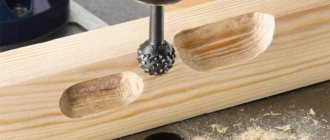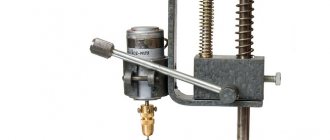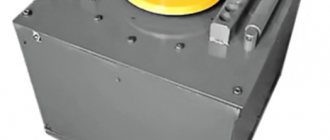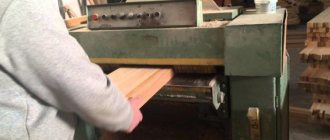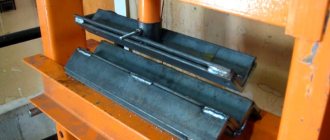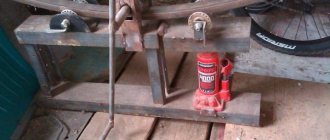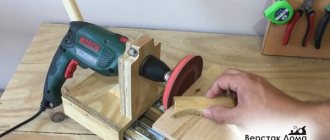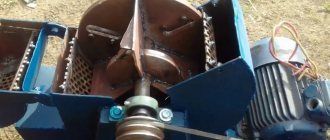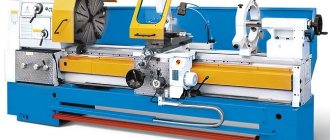Many home craftsmen are thinking about how to make their own metal lathe. This desire is explained by the fact that with the help of such a device, which will be very inexpensive, you can effectively perform a large range of turning operations, giving metal workpieces the required dimensions and shape. It would seem much easier to purchase a simple tabletop machine and use it in your workshop, but given the considerable cost of such equipment, it makes sense to spend time making it yourself.
A homemade lathe is quite possible
Capabilities of mini machines
A universal mini metal lathe is a real dream for the home craftsman. It allows you to perform a wide range of metalworking work. Having such equipment in your workshop, you no longer need to order expensive replacement parts and wait months for delivery from the supplier. Non-standard small metal parts can be made and modified yourself. Mini lathes are an ideal solution for a garage with a small car service center, a small non-core production workshop, a restoration workshop or a service station.
Structurally, the miniature machine is not very different from its full-size industrial counterparts. Although it is not possible to completely preserve functional diversity in the transition to a miniature size, all basic design elements are preserved:
- Bed.
- Caliper
- Headstock (spindle assembly).
Mini lathe device
The bed is the base, the basic and most massive part on which all other elements are attached, and movement occurs along it. In mini machines, the bed usually has fastenings for installation on a table or, in a more exotic version, on a wall
The support is used to install a processing tool, it can be a countersink, drill or cutter. It also provides a change of position.
The headstock usually contains a belt drive, an electric motor, a gearbox and a spindle. Using various types of chucks, the part for processing is clamped onto the headstock.
Main types of chucks:
- three-jaw;
- four-cam;
- collet;
- wedge;
- lever;
- drill chuck.
The workpiece is fixed in the spindle on the headstock. The tailstock moves along the guides of the base during processing and the tool located on it carries out the necessary processing.
Working on a mini machine
Tabletop mini lathes for metal belong to the category of screw-cutting lathes and can perform a fairly wide range of metalworking operations:
- thread cutting outside and inside the product;
- boring parts;
- drilling;
- applying grooves;
- trimming;
- countersinking.
Application area
Lathes are used for internal and external machining of cylindrical surfaces. Shafts, bushings, flanges, pulleys, couplings and other parts can be manufactured.
The workpiece is installed in a chuck, which rotates together with the spindle at specified speeds. The cutting tool makes a translational movement. Due to this, the workpiece acquires the desired shape and size.
Types of operations:
- End processing.
- Grinding the outer surface to a given diameter.
- Drilling and boring holes.
- Grooving.
- Cutting internal and external threads.
- Reaming and countersinking.
Classification of mini machines
Home turning and milling machines for metal can be divided into a number of characteristics:
- by weight - machines are produced weighing from 12.5 kg to 100 kg, greater weight and dimensions transfer them to the category of small production ones;
- in terms of power - the power of the machines ranges from 250 W to 700 W;
- voltage – 220 V or 380 V;
- according to the method of supplying cutting fluid - in the simplest models, lubrication occurs manually.
With a wide choice, you can choose the tool that will exactly match your needs and financial capabilities.
Machine mn80a
What causes injuries?
Factors that pose a threat to humans include:
- Spindle rotation
- Chips flying during processing
- Coolant splashes
- Machine voltage
- Sharp burrs on workpieces
Each worker is given instructions that describe all the points regarding the rules of behavior when operating the equipment. Operators are required to comply with all requirements.
Selecting a mini machine
When choosing equipment, you first need to focus on the parts to be processed. Of course, I want to provide a margin of functionality to cover possible future needs, but at the same time, the dimensions of the machine should be as compact as possible. True, we should not forget that the larger the machine, the more difficult it will be to install it in the workshop and move it around; moving a massive, even small-sized metal screw-cutting lathe weighing more than 50 kg alone is already very problematic.
An extremely important aspect when choosing is the ability to install additional equipment; often after purchase there is a need for some specific operation: grinding, knurling or milling. But if the purchased model does not allow you to install special equipment, you will have to forget about additional functions.
The required precision for processing parts is also a determining factor. For some parts, accuracy is measured in microns, and not everyone, even one declared as a precision high-precision unit, can provide such a request
The intensity of work determines the class of the machine. If work is carried out several times a month on an optional basis, we can talk about an amateur version, and when the machine is operated for 8-12 hours a day, it makes sense to purchase a professional version with a guaranteed output reserve.
The range of adjustment of the spindle speed is very important; if, for example, only wood or only copper parts are processed, you can do without adjustment. But to be able to process various materials: steel, cast iron, aluminum, you will have to choose an advanced model with precise speed control.
The determining factor for size is usually the dimensions of the workpieces (usually for mini lathes these are parts up to 400 mm in length and 300 mm in diameter).
A compact metal lathe, even in its “home” version, is a very complex device. In addition, the high rotational speed of the part and the load during the machining process place high demands on manufacturing quality. The materials of the machine, components, and the careful fit of parts will certainly affect the process of work, and when choosing based on the price factor, the owner may suffer serious disappointment, as well as a senseless financial loss.
Old Soviet models of wood and metal machines
Soviet equipment is still in use in production. Some people fundamentally prefer to equip their home workshops with units from the USSR.
Important!
It is sometimes difficult to find equipment or components for Soviet equipment in case of breakdown.
Screw-cutting lathe IT-1M
The lightweight machine was intended for gaining practice in workshops. Allows you to process cylindrical workpieces from the outside, drill and boring, and cut threads. Currently out of production.
During work
Safety precautions when operating the equipment:
- Securely secure workpieces;
- Remove chips in a timely manner using a special hook and prevent them from wrapping around the part;
- Monitor the proper operation of the machine; in case of deviation, stop work immediately;
- Support long parts either with movable supports (rests) or with a tailstock
Important! It seems stupid, but before work you MUST remove the key from the socket.
Prohibited:
- Touch the part with your hands or foreign objects;
- Work with gloves
- Try to fix equipment failure yourself;
- Cool parts with a damp cloth;
- Getting distracted while working;
- Transmit anything through operating equipment;
- Leave the machine running unattended.
After work
Upon completion of equipment operation, you must:
- Turn off the power;
- Clean the machine and the space around it from chips and liquids;
- Place tools, workpieces and parts;
- In the event of a breakdown, report it to management;
- Wash your hands and face thoroughly, take off your overalls.
General provisions
Persons who have completed all introductory instructions, fire safety instructions, and safety instructions are allowed to work on a lathe.
- Working on a lathe is impossible without special clothing. Headgear and safety glasses are required.
- Women are required to hide their hair under a headdress, however, this also applies to men.
- Hair should be styled in such a way as to exclude any possibility of it coming into contact with the rotating mechanisms of the machine.
Important! It is forbidden to use gloves while working, as threads protruding from them can get caught in the rotating chuck, which will lead to injury to the operator. The worker is also required to fasten all buttons on his sleeves for the same reasons.
The machine must be grounded and fixed. If it is being repaired, there should be a corresponding sign on it.
Activities not related to work are prohibited in the workplace: smoking, eating, using a mobile phone.
Workers under the influence of alcohol or drugs are not allowed to work on a lathe. Workers who are taking medications that slow their reactions are also not allowed.
